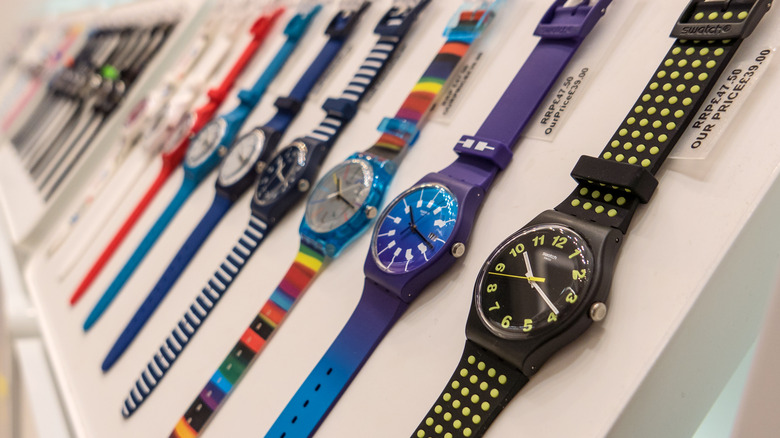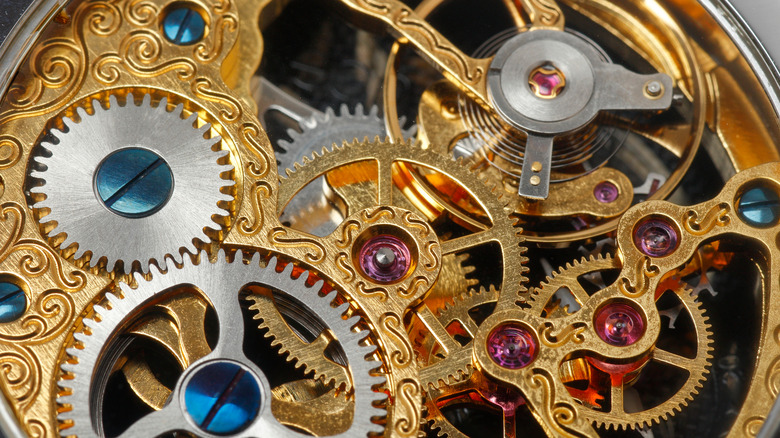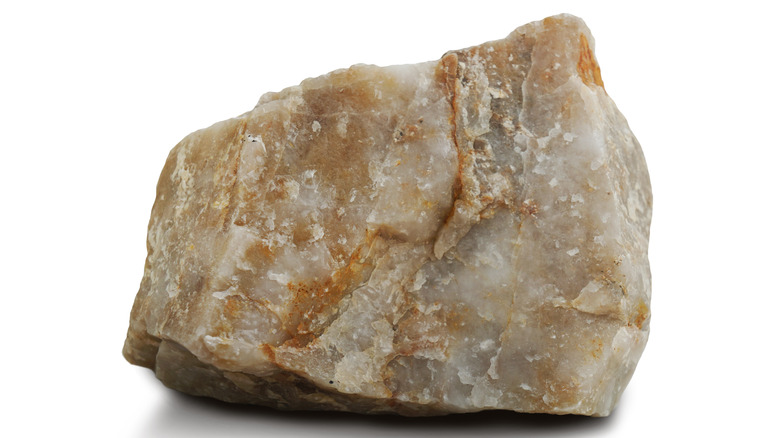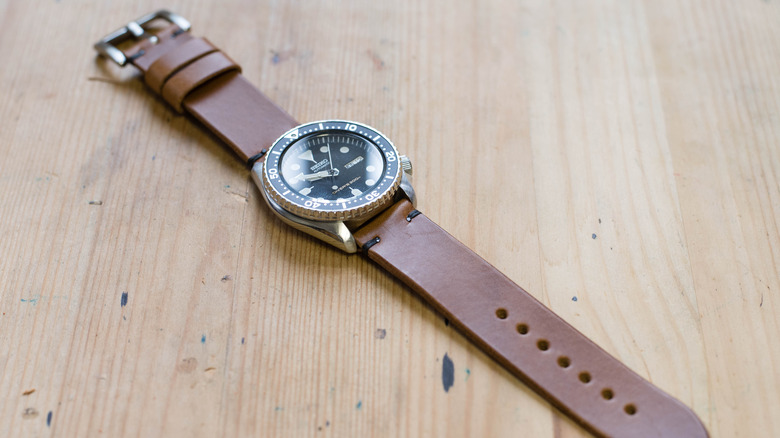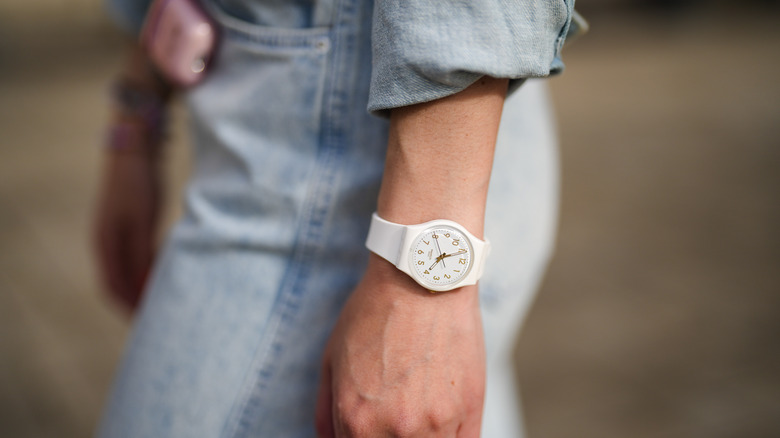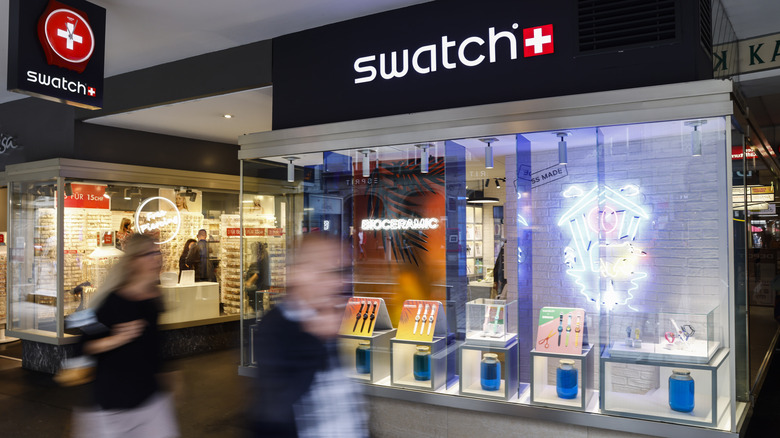What Happened To Swatch Watches?
Cheese. Neutrality. Watches. Those three things usually jump to mind when people think of Switzerland, although pocket knives could just as easily be up there too. Some of the biggest names in watches and watchmaking were either founded in Switzerland or eventually found their way there.
Rolex, for instance, was founded in London but has been based in Switzerland since 1919, and over the years that brand has gone on to become virtually synonymous with luxury and class (via Teddy Baldassarre). TAG Heuer is another iconic brand that can be traced back to the mid-19th century and is known for its association with auto racing, even offering a watch model called the Monaco, named after the principality that plays host to Formula 1's most iconic race.
While many Swiss watch brands are known for catering to those who have enough money to blow thousands on some wristwear without batting an eye, there's another Swiss brand that became famous for offering something totally different. Swatch watches were affordable and accessible — as long as they were in stock — and became hugely popular in the 1980s and 1990s (via Mental Floss).
The history of Swiss watchmaking
Clockmaking runs deep in Switzerland. According to the Federation of the Swiss Watch Industry, watchmaking first popped up in Geneva in the 16th century out of necessity after church reformer Jean Calvin banned wearing ornamental objects. This would have put goldsmiths and jewelers out of business if they hadn't picked up watchmaking. It didn't take long before the city had a reputation for producing high-quality watches, and in 1601 the first-of-its-kind Watchmakers Guild of Geneva was founded.
An overabundance of talented watchmakers in Geneva caused many of them to leave the city and settle elsewhere, in turn spreading the craft across the country. In the centuries that followed, Swiss watchmakers made technological advancements in their craft, and upon entering the 20th century, watches — like everything else — were being mass-produced. Soon to follow were wristwatches and electric-powered watches, but there would be a seismic shift in the watch industry starting in the 1960s with the introduction of quartz watches.
The quartz watch becomes a game-changer
One of the watch-related milestones that Switzerland can't claim is the first quartz watch, because that honor goes to Japan, specifically watch company Seiko (via Bloomberg). According to Explain That Stuff, quartz watches function by using a battery to run an electrical charge through a small piece of quartz — or silicon dioxide — that causes a certain number of vibrations per second which are counted and used to generate pulses at exact intervals that power a digital display or small motors. Quartz is one of the most common minerals on the planet, and its easy accessibility meant that watches could become more accurate and affordable.
Considering one of the major perks of a quartz watch is the affordability, it's pretty ironic that the original quartz watch, the Seiko Astron, carried a ¥450,000 price tag, which was the same price as a car when it was released in late 1969. The first run of Seiko Astrons number just 100 watches, but more were produced in 1972.
That same year, the digital watch made its debut in Lancaster, Pennsylvania. It was called the Pulsar, and cost over $2,000. The Pulsar used quartz technology, but instead of a traditional analog watch face, it had a futuristic digital display.
The predecessors to Swatch
By 1977, Seiko was the biggest watch company in the world in terms of revenue, and it was all thanks to their pioneering quartz technology (via Bloomberg). By comparison, the Swiss watch industry found themselves trailing their Japanese counterparts, and in 1978 some of the biggest watch companies in Switzerland started joining forces to keep up with the changing times.
One of these companies was called ETA SA, and they were responsible for launching a watch called the Delirium, which started a war with Seiko over who could produce the thinnest watches, until finally the subsequent Delirium IV ended up on top. More restructuring led to another new company called Swiss Corporation for Microelectronics and Watchmaking, or SMH, which is now known as the Swatch Group.
Following the success of the Delirium series, they started working on a project known internally as Delirium vulgare, which was Latin for "Delirium for the masses." They took steps to reduce cost and made the case out of plastic, and were able to produce a watch that retailed at just $35, and gave it the name Swatch.
Swatch watches are a massive success
Considering the Swiss watch industry's reputation for producing expensive timepieces, many were surprised to see a Swiss company make an attempt at tackling the lower end of the market. Still, Swatches were a hit and allowed anyone to get a genuine Swiss watch at an affordable price. According to Mental Floss, they were so popular that stores put per-person limits on Swatches. People desperate to feed their Swatch hunger went to great lengths to circumvent these limits by wearing wigs and disguises. Consumers went crazy for the variety of colors and designs Swatch watches offered, and special edition Swatches became collectors' items.
Swatches weren't just a pop-culture trend; they rejuvenated the Swiss watch industry. According to Bloomberg, the Swiss watchmakers had fallen behind when it came to using quartz technology. This caused employment to shrink. However, Swatches changed that and by the mid-1980s, 80% of Swiss watches used quartz. SMH, the company that introduced the Swatch, also found themselves out of debt thanks to their popular timepiece.
Swatch today
While Swatch watches are no longer as hugely popular as they were at their peak, they're still available today. SMH changed its name to The Swatch Group as a nod to its famous watches, and according to the company's website they are the "number one manufacturer of finished watches in the world."
The Swatch Group is now comprised of many brands of watches that hit every price point and part of the watch market. Swatches are still sold as one of the company's budget-friendly brands. However, Mental Floss reported that the rise of smartwatches has cut into the company's sales figures.
Vintage Swatches can still fetch a pretty penny from collectors. In 2015, The Dunkel Collection — the largest collection of Swatch watches in the world, made up of 5,800 watches and some art pieces — was sold by Sotheby's Hong Kong for a staggering $6 million. Paul Dunkel, who put the Dunkel in The Dunkel Collection, cited this sale as yet another example of the cultural impact of Swatch watches. "This is a true testament to the universal appeal of Swatch," he said in a statement on The Swatch Group website.
